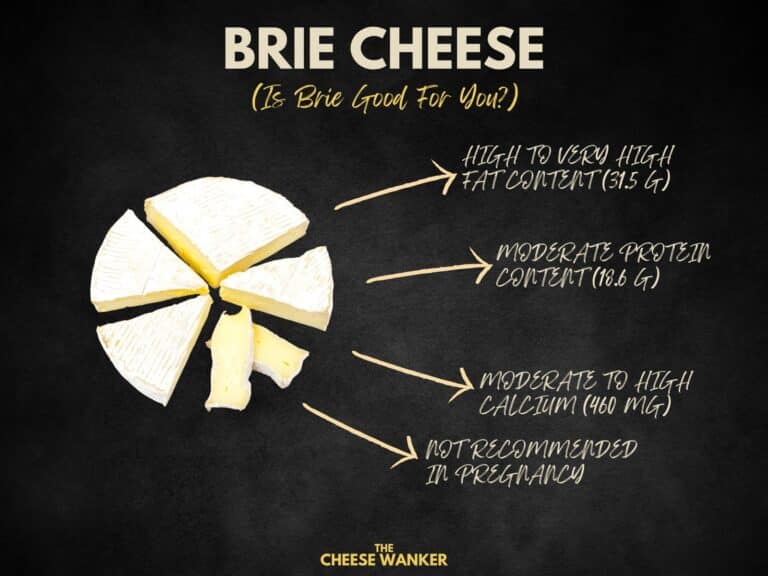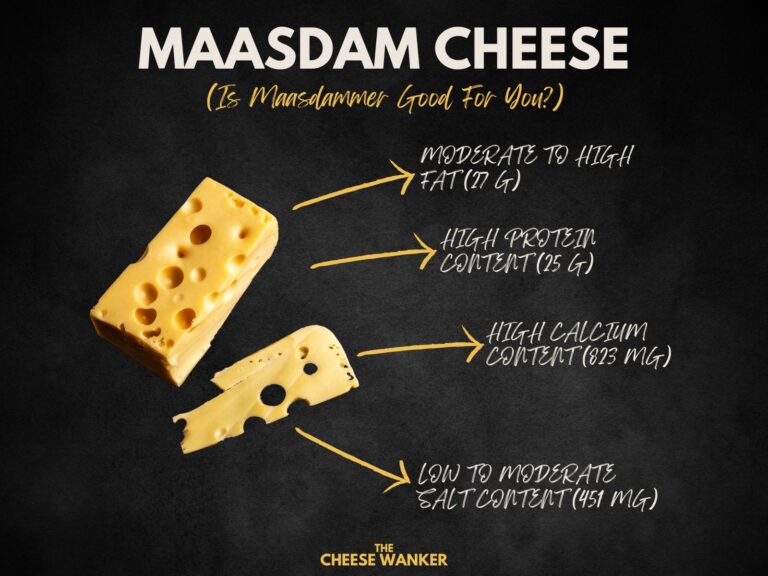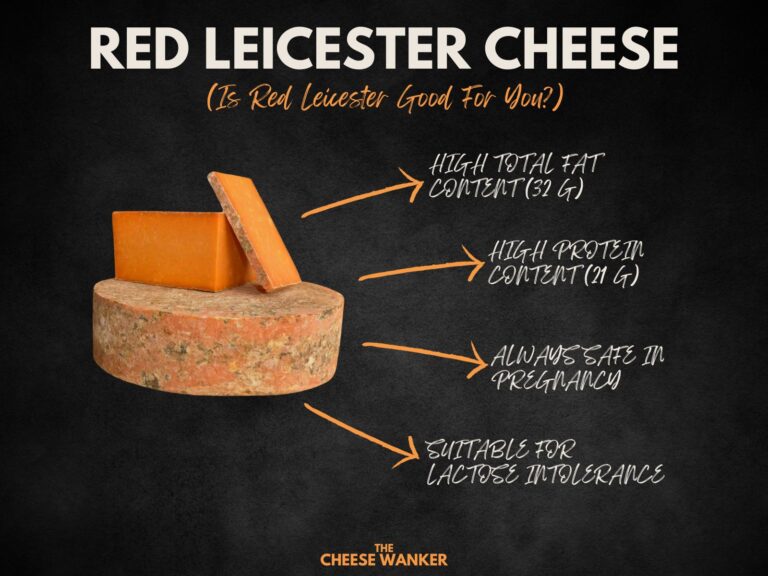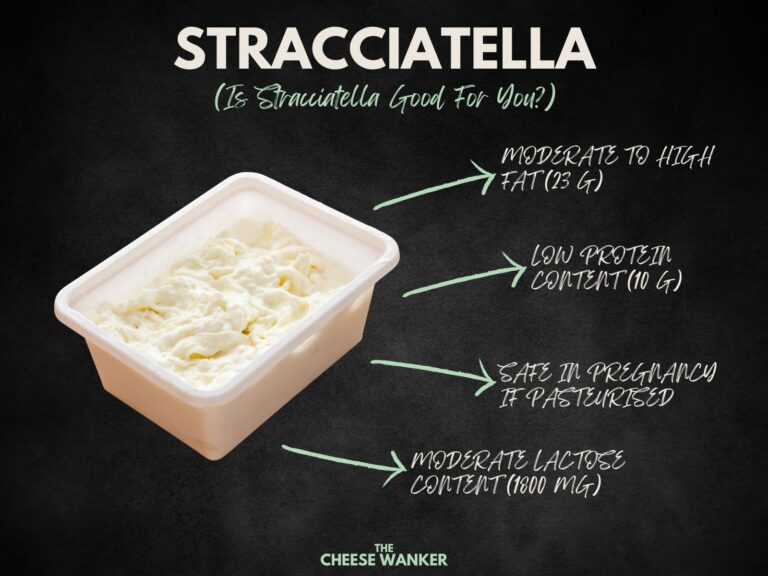Fontina has got to be one of Italy’s most criminally underrated cheeses! This semi-soft pressed cheese is a popular choice locally as both a table cheese and a cooking cheese. However, beyond its delectable taste, it is essential to understand the nutritional profile of this cheese to make informed dietary choices. Join us as we delve into the lactose content, safety in pregnancy status and nutrition facts of Fontina.
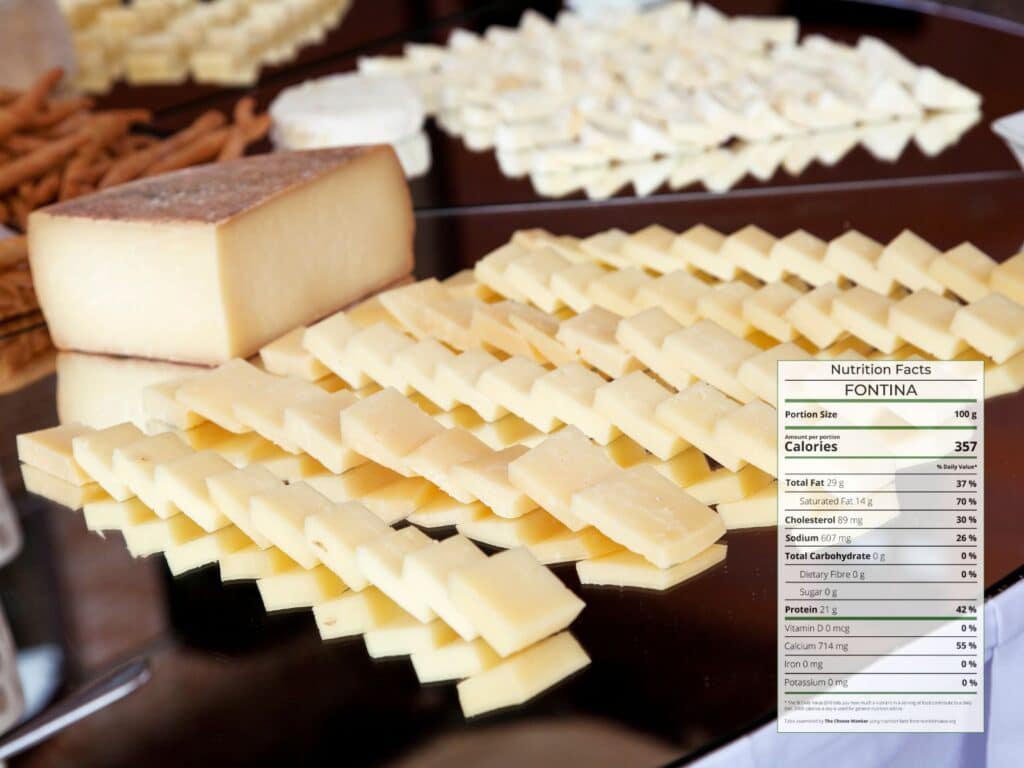
SEE ALSO: Nutrition facts for popular world cheeses in The Cheese Wanker’s index →
What is Fontina?
Fontina cheese is an aged cow’s milk cheese originating from the Aosta Valley in Italy. It possesses a pale-yellow paste and a creamy texture with occasional small holes throughout.
Renowned for its delicate nutty flavour and meltable texture, Fontina cheese is often used in a wide array of dishes, including fondue, gratins and sandwiches.
Nutrition fact sheet
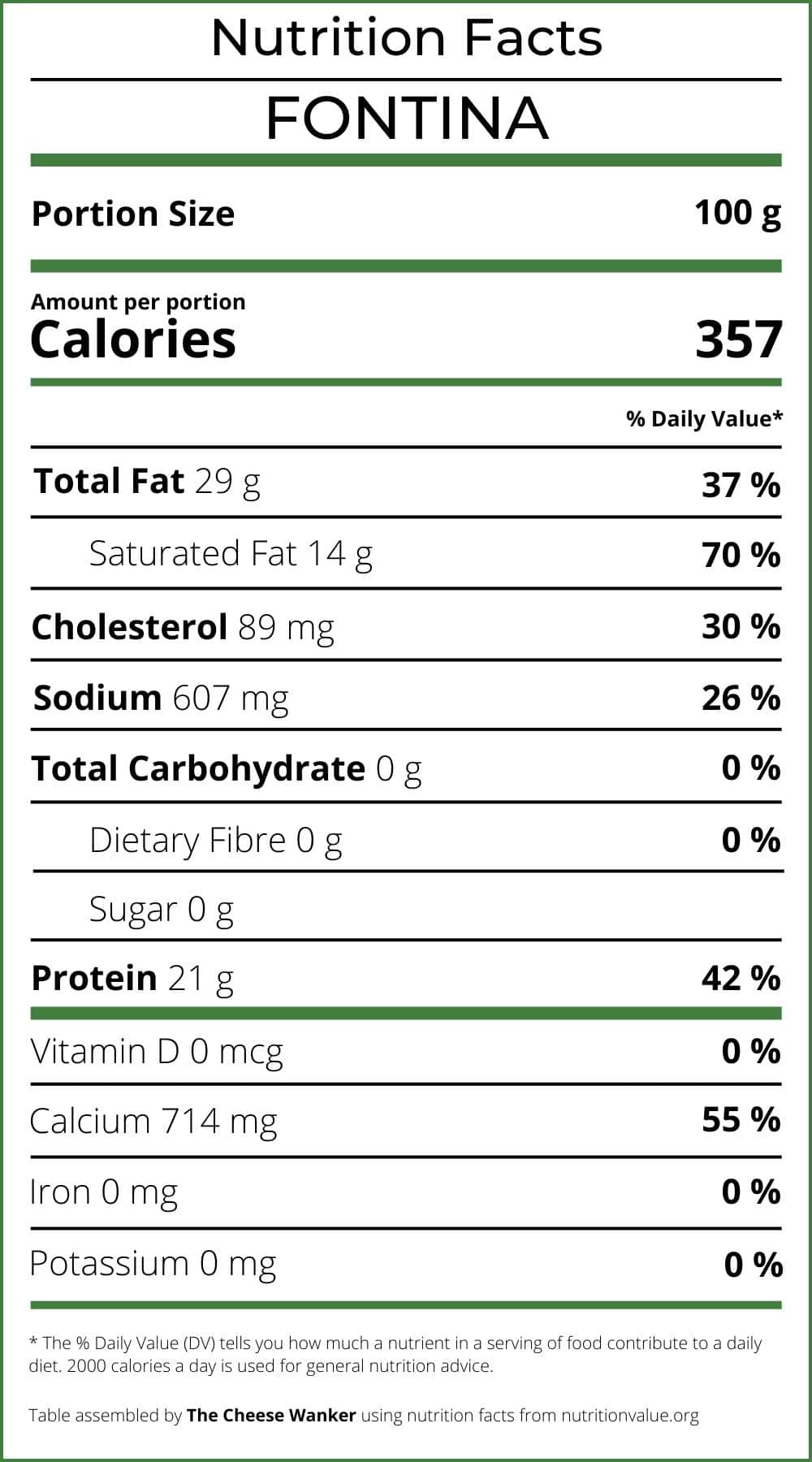
Nutritional review for Fontina
Eating healthy plays a pivotal role in maintaining overall well-being and preventing chronic diseases. A balanced and nutritious diet provides our bodies with essential vitamins, minerals, and macronutrients, fuelling optimal physical and cognitive function.
With this in mind, let’s have a look at some of the key nutrition facts for Fontina.
Lactose Intolerance
For lactose intolerant cheese lovers, Fontina can be an excellent option. Due to the ageing process, the lactose content in Fontina significantly decreases. This reduction in lactose makes it more tolerable for those who have difficulty digesting lactose, as compared to fresh cheeses.
Consequently, Fontina cheese can usually be enjoyed by individuals with lactose intolerance, provided they monitor their own tolerance levels. Having said that, sensitivity to lactose varies from one person to the next. So, if trying this cheese for the first time, we recommend starting with a small portion (less than 50 g).
Fat Content
Undoubtedly, Fontina is a rich source of fat. A 100-gram serving of Fontina cheese typically contains around 28-30 grams of fat. While it is essential to consume fat in moderation, the fat content in Fontina cheese can contribute to satiety and aid in the absorption of fat-soluble vitamins.
However, individuals following a low-fat diet should be mindful of their portion sizes. On the other hand, its high fat and low carb profile make Fontina an excellent option for people following a ketogenic diet.
You can learn more about the different types of fat in cheese and which cheeses have the lowest fat content here.
Cholesterol Content
Fontina, like most dairy products, contains cholesterol. Indeed, a 100 gram serve of Fontina cheese yields around 89 milligrams of cholesterol.
While dietary cholesterol does not have as significant an impact on blood cholesterol levels as once believed, individuals with specific dietary restrictions or conditions should consume Fontina in moderation.
Protein Content
Moreover, Fontina cheese contains a significant amount of protein, making it a valuable addition to a balanced diet. In a 100-gram serving, Fontina cheese provides approximately 21 grams of protein.
Protein is essential for tissue repair, muscle development, and overall growth and maintenance. Hence, incorporating Fontina into your meals can help meet your protein requirements effectively.
Want to find out which cheeses have the highest protein content? Click here for our blog post covering cheeses with the highest protein content.
*Safety in Pregnancy
Pregnant women often seek guidance regarding food choices to ensure the well-being of both themselves and their unborn child. Fontina cheese is generally considered safe to consume during pregnancy, provided it is made from pasteurised milk. Pasteurisation eliminates harmful bacteria, minimising the risk of foodborne illnesses.
Having said that, you can still cook a delicious meal with a raw milk Fontina because heating up the cheese will significantly reduce the risk of Listeria contamination. Pregnant women should, however, consult with their healthcare provider for personalised advice.
You can read more about which cheeses you can eat when you’re pregnant by clicking here.
Salt Content
Depending on the manufacturer, Fontina contains varying amounts of sodium, contributing to its savoury taste. It is important to note that excessive sodium intake can have adverse health effects.
While Fontina cheese may enhance the flavour of your dishes, moderation is key. Individuals with specific dietary restrictions, such as those with hypertension, should monitor their sodium intake and consume Fontina cheese in moderation.
You can read more about why salt is important in cheesemaking in our comprehensive post here.
Calcium Content
Finally, Fontina is an excellent source of calcium, a vital mineral for maintaining healthy bones and teeth, as well as supporting various physiological processes. A 100-gram serving of Fontina cheese provides approximately 700 milligrams of calcium.
Therefore, including Fontina in your diet can help meet your daily calcium requirements, especially for individuals who may be lactose intolerant and cannot obtain calcium from other dairy sources.
Conclusion
To conclude, Fontina, with its distinctive taste and creamy texture, offers more than just a flavourful experience. Understanding its nutrition facts is crucial for individuals seeking to make informed dietary choices.
With reduced lactose content, Fontina cheese can be enjoyed by those with lactose intolerance. Its moderate fat content, coupled with valuable protein, makes it a noteworthy addition to a balanced diet.
What’s your favourite dish to melt Fontina into? Drop us a line in the comments below.
References
Overall nutritional content
The nutritional content of cheese in our table comes from the USDA Food Data Central Repository, the Australian Food Composition Database and cheese manufacturers. We realise that there can be variations between different brands and producers. Hence, the numbers we have used are averages.
Fat content
Our fat RDI data comes from Cleveland Clinic’s Healthy Fat Intake resource.
Type of fat in cheese as per Harvard T.H. Chan’s The Nutrition Source.
Protein content
Our protein RDI data comes from Harvard Medical School’s Harvard Health Publishing.
Cholesterol content
Is There a Correlation between Dietary and Blood Cholesterol? Evidence from Epidemiological Data and Clinical Interventions? – Maria Luz Fernandez and Ana Gabriela Murillo
Saturated fat, carbohydrate, and cardiovascular disease – Patty W Siri-Tarino, Qi Sun, Frank B Hu and Ronald M Krauss
Effect of cheese consumption on blood lipids: a systematic review and meta-analysis of randomized controlled trials – Janette de Goede, Johanna M Geleijnse, Eric L Ding, Sabita S Soedamah-Muthu
Safety in pregnancy
All the advice relating to what cheeses you can eat during pregnancy in this article is based on the recommendations by health authorities in Australia, the UK and the USA. If you are unsure about what you can or cannot eat, please consult your doctor.
Australia – FSANZ, United Kingdom – NHS and United Sates of America – FDA
Lactose content
Lactose residual content in PDO cheeses
Detection of lactose in products with low lactose content
The analysis of lactose in milk and cheese products by HPLC
Food Standards ANZ Food Composition Database
Lactose & Galactose content of cheese
